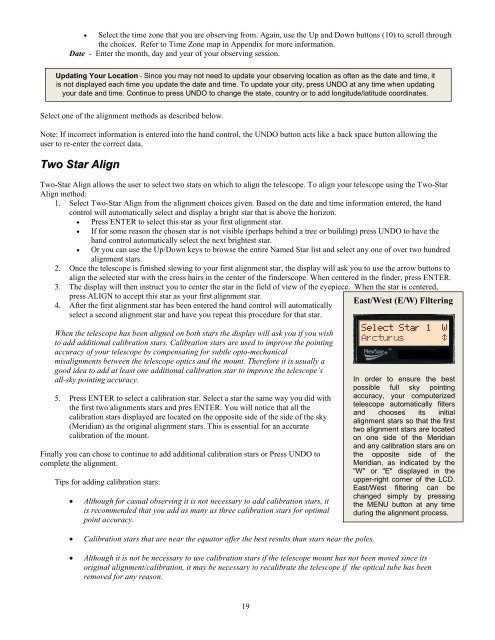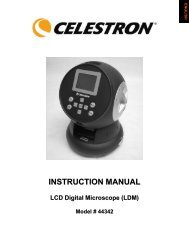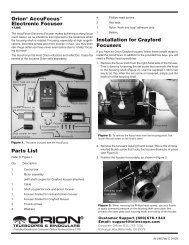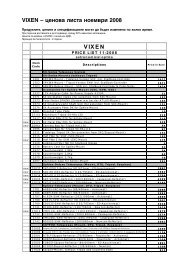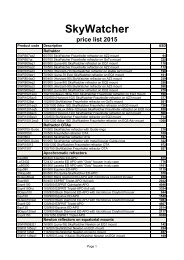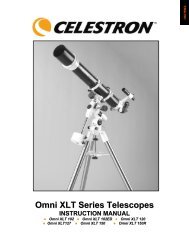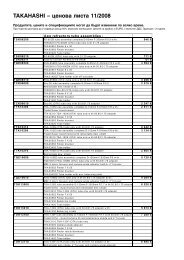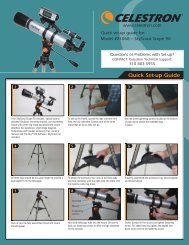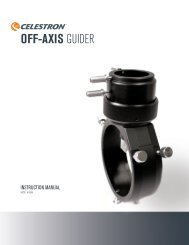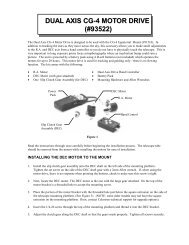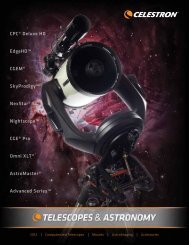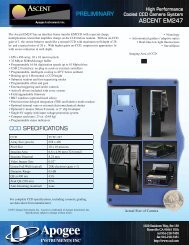Create successful ePaper yourself
Turn your PDF publications into a flip-book with our unique Google optimized e-Paper software.
Select the time zone that you are observing from. Again, use the Up and Down buttons (10) to scroll throughthe choices. Refer to Time Zone map in Appendix for more information.Date - Enter the month, day and year of your observing session.Updating Your Location - Since you may not need to update your observing location as often as the date and time, itis not displayed each time you update the date and time. To update your city, press UNDO at any time when updatingyour date and time. Continue to press UNDO to change the state, country or to add longitude/latitude coordinates.Select one of the alignment methods as described below.Note: If incorrect information is entered into the hand control, the UNDO button acts like a back space button allowing theuser to re-enter the correct data.Two Star AlignTwo-Star Align allows the user to select two stars on which to align the telescope. To align your telescope using the Two-StarAlign method:1. Select Two-Star Align from the alignment choices given. Based on the date and time information entered, the handcontrol will automatically select and display a bright star that is above the horizon. Press ENTER to select this star as your first alignment star. If for some reason the chosen star is not visible (perhaps behind a tree or building) press UNDO to have thehand control automatically select the next brightest star.Or you can use the Up/Down keys to browse the entire Named Star list and select any one of over two hundredalignment stars.2. Once the telescope is finished slewing to your first alignment star, the display will ask you to use the arrow buttons toalign the selected star with the cross hairs in the center of the finderscope. When centered in the finder, press ENTER.3. The display will then instruct you to center the star in the field of view of the eyepiece. When the star is centered,press ALIGN to accept this star as your first alignment star.4. After the first alignment star has been entered the hand control will automaticallyselect a second alignment star and have you repeat this procedure for that star.East/West (E/W) FilteringWhen the telescope has been aligned on both stars the display will ask you if you wishto add additional calibration stars. Calibration stars are used to improve the pointingaccuracy of your telescope by compensating for subtle opto-mechanicalmisalignments between the telescope optics and the mount. Therefore it is usually agood idea to add at least one additional calibration star to improve the telescope’sall-sky pointing accuracy.5. Press ENTER to select a calibration star. Select a star the same way you did withthe first two alignments stars and pres ENTER. You will notice that all thecalibration stars displayed are located on the opposite side of the side of the sky(Meridian) as the original alignment stars. This is essential for an accuratecalibration of the mount.Finally you can chose to continue to add additional calibration stars or Press UNDO tocomplete the alignment.Tips for adding calibration stars:Although for casual observing it is not necessary to add calibration stars, itis recommended that you add as many as three calibration stars for optimalpoint accuracy.In order to ensure the bestpossible full sky pointingaccuracy, your computerizedtelescope automatically filtersand chooses its initialalignment stars so that the firsttwo alignment stars are locatedon one side of the Meridianand any calibration stars are onthe opposite side of theMeridian, as indicated by the"W" or "E" displayed in theupper-right corner of the LCD.East/West filtering can bechanged simply by pressingthe MENU button at any timeduring the alignment process.Calibration stars that are near the equator offer the best results than stars near the poles.Although it is not be necessary to use calibration stars if the telescope mount has not been moved since itsoriginal alignment/calibration, it may be necessary to recalibrate the telescope if the optical tube has beenremoved for any reason.19


